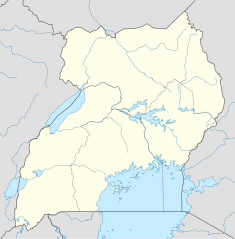- Bugoye Power Station
-
Bugoye Power Station Map of Uganda showing the location of Bugoye Station Country Uganda Location Bugoye, Kasese District Coordinates 00°18′00″N 30°06′02″E / 0.3°N 30.10056°ECoordinates: 00°18′00″N 30°06′02″E / 0.3°N 30.10056°E Status Operational Commission date 7 October 2009 Power station information Primary fuel Hydropower Generation units 2 Power generation information Maximum capacity 13 MW Bugoye Power Station is a 13 MW mini hydroelectric power station in Uganda.
Contents
Location
The power station is located across the Mubuku River, in Bugoye, Kasese District, in Western Uganda. This location lies in the foothills of the Rwenzori Mountains, close to the border with the Democratic Republic of the Congo. Bugoye lies approximately 19 kilometres (12 mi), by road, north of Kasese, the location of the district headquarters, and the nearest large city.[1] The coordinates of the power station are: 00 18 00N, 30 06 02E (Latitude:0.3000; Longitude:30.1005).
Overview
The Bugoye Hydropower Project, is a run of the river mini-hydropower installation, with installed capacity of 13 MW. The energy generated is fed into the national electric grid at Nkenda Substation, located 6 kilometres (3.7 mi) from Bugoye, via a 33kV transmission line.
The power station is owned and operated by Tronder Power Limited, a Norwegian power company. Construction began in March 2008 and the plant was commissioned 19 months later in October 2009.[2] Bugoye Power Station is the third mini-hydropower station on River Mubuku. The other two are Mubuku I Power Station, owned by Kilembe Mines Limited (KML), with installed capacity of 5 MW and Mubuku III Power Station, owned by Kasese Cobalt Company Limitd (KCCL), with installed capacity of 10 MW. In the literature, Bugoye Power Station is sometimes referred to as Mubuku II Power Station.[3]
Construction costs
The estimated costs for the dam and power plant is approximately US$35 million. The funding was facilitated by a loan from the Emerging Africa Infrastructure Fund, (EAIF). This does not include the construction of a 33kV transmission power line linking the power station to the substation where the power is integrated into the national grid. The power line was funded by a grant from the Government of Norway to the Government of Uganda. By mutual consent between the two governments, Tronder Power Limited assumed the responsibility of developing, constructing, maintaining and servicing the power line.[4]
External links
See also
- List of power stations in Uganda
- List of hydropower stations in Africa
- List of hydroelectric power stations
- Mubuku
- Hima
- Kasese
- Kasese District
- Western Region, Uganda
References
 Kasese DistrictCapital: Kasese
Kasese DistrictCapital: KaseseTowns and villages Economy Barclays Bank · Centenary Bank · Equity Bank (Uganda) · Stanbic Bank · PostBank Uganda · Pride Microfinance Limited · Bugoye Power Station · Hima Cement Limited · Hotel Margarita · Kilembe Mines Limited · Kilembe Cobalt Company Limited · Mubuku I Power Station · Mubuku III Power StationNotable landmarks Kasese Airport · Rwenzori Mountains · Rwenzori National Park · Queen Elizabeth National Park · Lake Edward · Lake George · Kazinga Channel · Kasese Hospital · Kagando Hospital · Bwera General Hospital · Kilembe Hospital · Kasese Central Market · Kasenyi Airport · Mweya Airport · Roman Catholic Diocese of KaseseNotable people Categories:- Hydroelectric power stations in Uganda
- Kasese District
- Western Region, Uganda
Wikimedia Foundation. 2010.

